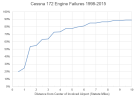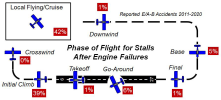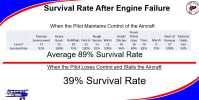Reminded of the famous Bob Hoover engine failure. One of Bob’s favorite pieces of advice for new pilots was this: When faced with a forced landing, fly the airplane as far through the crash as possible.
https://check-six.com/Crash_Sites/N2300H-Hoover-1978.htm
On the afternoon of Saturday, May 25, 1978, Hoover had just completed performances in his P-51 and the Shrike Commander before an audience of 6,000. Having an appointment back at his home airport of Palomar, Hoover coordinated fueling his Rockwell 500S “Shrike Commander,” registered as N2300H, so he could leave right after the show was completed. When the young man asked how much fuel Hoover needed, he said he wanted precisely sixty gallons, adding ‘“That’s 100 octane.”
After Hoover’s performance, the pilot went to the airport manager’s office, where he received a phone call from the same young man, confirming that 100 LL (low lead) was all right for the airplane. Hoover confirmed that was correct, which the manager relayed over the phone.
Hoover had a practice of being present whenever the airplane was being serviced but was held up when coming out of the airport manager’s office. By the time he got to the Shrike, the fuel truck was pulling away. Hoover asked if the fueling was done, to which the line service boy replied, “Yes, sir. It was sixty gallons precisely.”
Hoover loaded his two passengers aboard and started the two 290 horsepower Lycoming IO-540 air-cooled flat-six piston engines. Taxiing out, scores of aircraft were ahead of him, awaiting clearance to depart from the field. But as soon as he called in, the tower said, “Mr. Hoover, we want you to taxi to the head of the line.”
Initially, Hoover was hesitant, not liking to leapfrog ahead of other pilots. However, since he was short for time, he accepted the tower’s offer, taxied on to the runway, ran up the engines, and made a smooth takeoff, heading north.
As Hoover recalled, “Everything was normal and checked out perfectly. All of a sudden, at about three hundred feet, I realized I didn’t have any power in the Shrike. I started losing airspeed.”
Instantly, he released the back pressure on the Shrike control yoke, but “couldn’t understand what was happening,” he recounted in his autobiography. “Everything checked out. The manifold pressure was right where it was supposed to be. The RPMs were at the right setting. The fuel pressure and oil pressure were in good shape. Even though the gauges indicated that nothing was wrong, I knew something was. I started looking for a place to land. That would not be easy.”
But Brown Field is atop a mesa, surrounded by deep ravines, and returning to the airport was out of the question. Hoover’s two passengers tried to remain calm, but were frightened, thinking that whatever that was going to happen would end poorly. “Mr. Hoover,” they asked more than once, “are we going to make it?”
Hoover assured them they would, relying on his decades of experience in anticipating trouble.
He promptly pushed the control yoke forward to accelerate and maintain the plane’s best glide speed until it reached the very end of the ravine.
As Hoover bled off the plane’s airspeed, he lowered the landing gear and wing flaps to minimize the forward speed and inertia on impact. Down in a V-shaped ravine, it measured a thousand feet wide at the top, narrowing down to nothing at the bottom. Hoover flew down to the bottom to maintain the best glide speed, and pulled the plane up, placing it into the side of the ravine. The plane didn’t travel very far at all before hitting a rock pile that caved in the nose and ripped the instrument panel from its mounts and onto Hoover’s shins.
Neither the passengers nor Hoover were hurt. At the trio sat and awaited rescue, Hoover pondered what had caused the lack of power. He quickly deduced that there was only one possibility: the plane had been serviced with jet fuel instead of gasoline.
To confirm his suspicions, Hoover went around to the side of the airplane and opened the drain valve. Leaning down, he took a whiff of the fuel and was greeted with the distinct aroma of jet fuel. The plane had been able to take off with the remaining aviation fuel in the engines and fuel lines, but as soon as the jet fuel reached the engines, they cut out!
Hoover quickly recalled the young man he had asked to service the airplane and realized that he must have known by then what had happened as Hoover had informed the tower of the emergency.
Within minutes, rescue helicopters hovered over the wreckage, and the threesome climbed up the ravine to be transported back to Brown Field.



